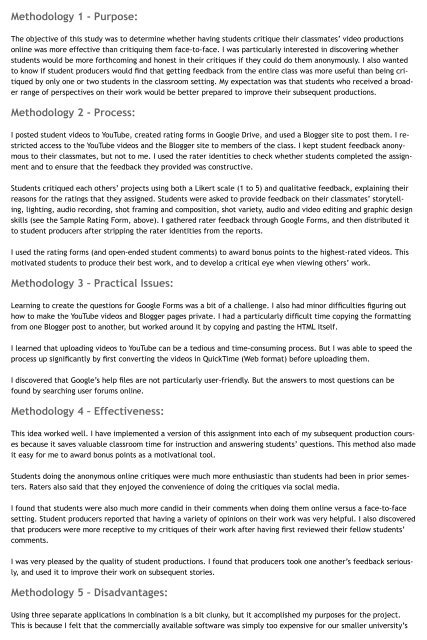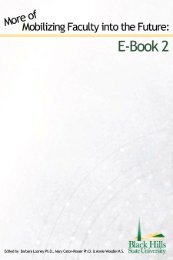Mobilizing Faculty into the Future: Using Online Technology as Teaching Tools
Create successful ePaper yourself
Turn your PDF publications into a flip-book with our unique Google optimized e-Paper software.
Methodology 1 - Purpose:<br />
The objective of this study w<strong>as</strong> to determine whe<strong>the</strong>r having students critique <strong>the</strong>ir cl<strong>as</strong>smates’ video productions<br />
online w<strong>as</strong> more effective than critiquing <strong>the</strong>m face-to-face. I w<strong>as</strong> particularly interested in discovering whe<strong>the</strong>r<br />
students would be more forthcoming and honest in <strong>the</strong>ir critiques if <strong>the</strong>y could do <strong>the</strong>m anonymously. I also wanted<br />
to know if student producers would find that getting feedback from <strong>the</strong> entire cl<strong>as</strong>s w<strong>as</strong> more useful than being critiqued<br />
by only one or two students in <strong>the</strong> cl<strong>as</strong>sroom setting. My expectation w<strong>as</strong> that students who received a broader<br />
range of perspectives on <strong>the</strong>ir work would be better prepared to improve <strong>the</strong>ir subsequent productions.<br />
Methodology 2 - Process:<br />
I posted student videos to YouTube, created rating forms in Google Drive, and used a Blogger site to post <strong>the</strong>m. I restricted<br />
access to <strong>the</strong> YouTube videos and <strong>the</strong> Blogger site to members of <strong>the</strong> cl<strong>as</strong>s. I kept student feedback anonymous<br />
to <strong>the</strong>ir cl<strong>as</strong>smates, but not to me. I used <strong>the</strong> rater identities to check whe<strong>the</strong>r students completed <strong>the</strong> <strong>as</strong>signment<br />
and to ensure that <strong>the</strong> feedback <strong>the</strong>y provided w<strong>as</strong> constructive.<br />
Students critiqued each o<strong>the</strong>rs’ projects using both a Likert scale (1 to 5) and qualitative feedback, explaining <strong>the</strong>ir<br />
re<strong>as</strong>ons for <strong>the</strong> ratings that <strong>the</strong>y <strong>as</strong>signed. Students were <strong>as</strong>ked to provide feedback on <strong>the</strong>ir cl<strong>as</strong>smates’ storytelling,<br />
lighting, audio recording, shot framing and composition, shot variety, audio and video editing and graphic design<br />
skills (see <strong>the</strong> Sample Rating Form, above). I ga<strong>the</strong>red rater feedback through Google Forms, and <strong>the</strong>n distributed it<br />
to student producers after stripping <strong>the</strong> rater identities from <strong>the</strong> reports.<br />
I used <strong>the</strong> rating forms (and open-ended student comments) to award bonus points to <strong>the</strong> highest-rated videos. This<br />
motivated students to produce <strong>the</strong>ir best work, and to develop a critical eye when viewing o<strong>the</strong>rs’ work.<br />
Methodology 3 – Practical Issues:<br />
Learning to create <strong>the</strong> questions for Google Forms w<strong>as</strong> a bit of a challenge. I also had minor difficulties figuring out<br />
how to make <strong>the</strong> YouTube videos and Blogger pages private. I had a particularly difficult time copying <strong>the</strong> formatting<br />
from one Blogger post to ano<strong>the</strong>r, but worked around it by copying and p<strong>as</strong>ting <strong>the</strong> HTML itself.<br />
I learned that uploading videos to YouTube can be a tedious and time-consuming process. But I w<strong>as</strong> able to speed <strong>the</strong><br />
process up significantly by first converting <strong>the</strong> videos in QuickTime (Web format) before uploading <strong>the</strong>m.<br />
I discovered that Google’s help files are not particularly user-friendly. But <strong>the</strong> answers to most questions can be<br />
found by searching user forums online.<br />
Methodology 4 – Effectiveness:<br />
This idea worked well. I have implemented a version of this <strong>as</strong>signment <strong>into</strong> each of my subsequent production courses<br />
because it saves valuable cl<strong>as</strong>sroom time for instruction and answering students’ questions. This method also made<br />
it e<strong>as</strong>y for me to award bonus points <strong>as</strong> a motivational tool.<br />
Students doing <strong>the</strong> anonymous online critiques were much more enthusi<strong>as</strong>tic than students had been in prior semesters.<br />
Raters also said that <strong>the</strong>y enjoyed <strong>the</strong> convenience of doing <strong>the</strong> critiques via social media.<br />
I found that students were also much more candid in <strong>the</strong>ir comments when doing <strong>the</strong>m online versus a face-to-face<br />
setting. Student producers reported that having a variety of opinions on <strong>the</strong>ir work w<strong>as</strong> very helpful. I also discovered<br />
that producers were more receptive to my critiques of <strong>the</strong>ir work after having first reviewed <strong>the</strong>ir fellow students’<br />
comments.<br />
I w<strong>as</strong> very ple<strong>as</strong>ed by <strong>the</strong> quality of student productions. I found that producers took one ano<strong>the</strong>r’s feedback seriously,<br />
and used it to improve <strong>the</strong>ir work on subsequent stories.<br />
Methodology 5 – Disadvantages:<br />
<strong>Using</strong> three separate applications in combination is a bit clunky, but it accomplished my purposes for <strong>the</strong> project.<br />
This is because I felt that <strong>the</strong> commercially available software w<strong>as</strong> simply too expensive for our smaller university’s






